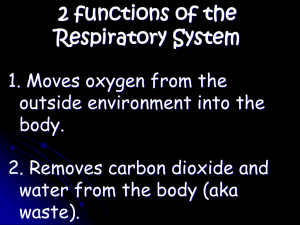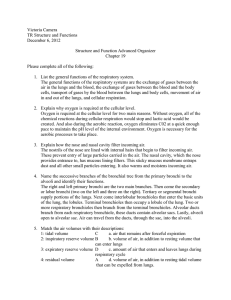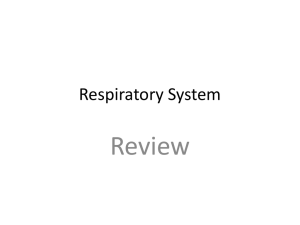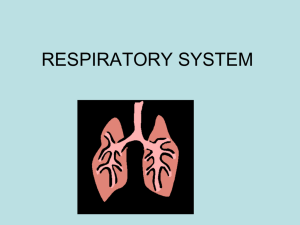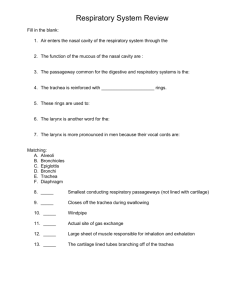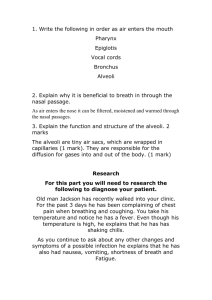A&P Chapter 23 Review KEY 17. The route of air from the external
advertisement
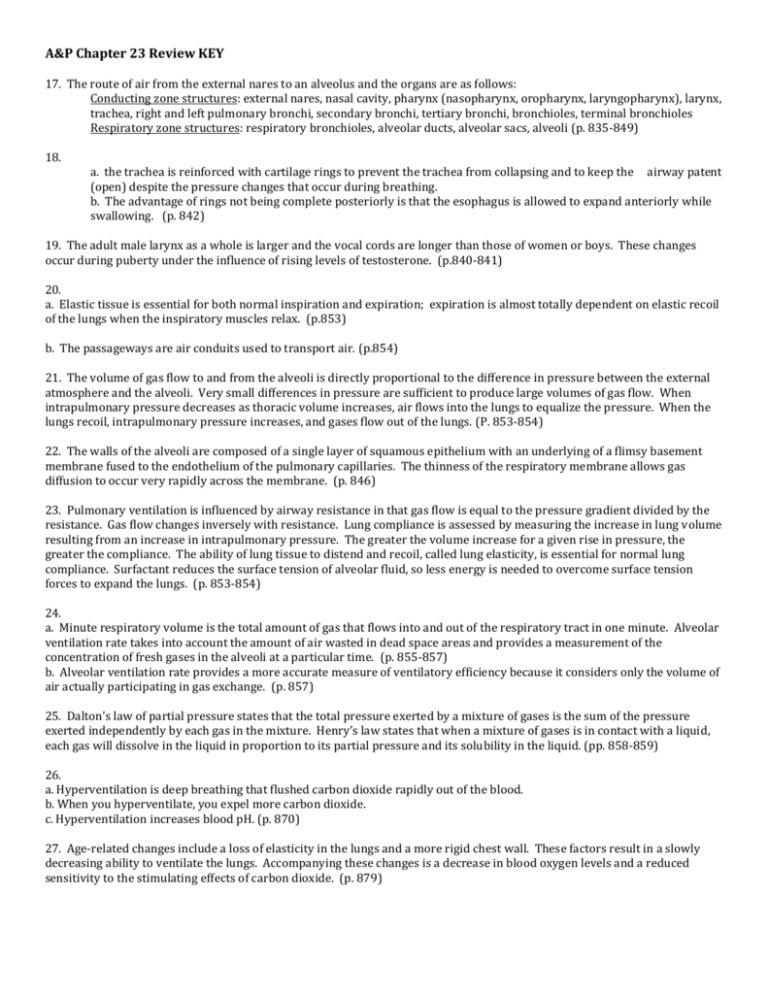
A&P Chapter 23 Review KEY 17. The route of air from the external nares to an alveolus and the organs are as follows: Conducting zone structures: external nares, nasal cavity, pharynx (nasopharynx, oropharynx, laryngopharynx), larynx, trachea, right and left pulmonary bronchi, secondary bronchi, tertiary bronchi, bronchioles, terminal bronchioles Respiratory zone structures: respiratory bronchioles, alveolar ducts, alveolar sacs, alveoli (p. 835-849) 18. a. the trachea is reinforced with cartilage rings to prevent the trachea from collapsing and to keep the airway patent (open) despite the pressure changes that occur during breathing. b. The advantage of rings not being complete posteriorly is that the esophagus is allowed to expand anteriorly while swallowing. (p. 842) 19. The adult male larynx as a whole is larger and the vocal cords are longer than those of women or boys. These changes occur during puberty under the influence of rising levels of testosterone. (p.840-841) 20. a. Elastic tissue is essential for both normal inspiration and expiration; expiration is almost totally dependent on elastic recoil of the lungs when the inspiratory muscles relax. (p.853) b. The passageways are air conduits used to transport air. (p.854) 21. The volume of gas flow to and from the alveoli is directly proportional to the difference in pressure between the external atmosphere and the alveoli. Very small differences in pressure are sufficient to produce large volumes of gas flow. When intrapulmonary pressure decreases as thoracic volume increases, air flows into the lungs to equalize the pressure. When the lungs recoil, intrapulmonary pressure increases, and gases flow out of the lungs. (P. 853-854) 22. The walls of the alveoli are composed of a single layer of squamous epithelium with an underlying of a flimsy basement membrane fused to the endothelium of the pulmonary capillaries. The thinness of the respiratory membrane allows gas diffusion to occur very rapidly across the membrane. (p. 846) 23. Pulmonary ventilation is influenced by airway resistance in that gas flow is equal to the pressure gradient divided by the resistance. Gas flow changes inversely with resistance. Lung compliance is assessed by measuring the increase in lung volume resulting from an increase in intrapulmonary pressure. The greater the volume increase for a given rise in pressure, the greater the compliance. The ability of lung tissue to distend and recoil, called lung elasticity, is essential for normal lung compliance. Surfactant reduces the surface tension of alveolar fluid, so less energy is needed to overcome surface tension forces to expand the lungs. (p. 853-854) 24. a. Minute respiratory volume is the total amount of gas that flows into and out of the respiratory tract in one minute. Alveolar ventilation rate takes into account the amount of air wasted in dead space areas and provides a measurement of the concentration of fresh gases in the alveoli at a particular time. (p. 855-857) b. Alveolar ventilation rate provides a more accurate measure of ventilatory efficiency because it considers only the volume of air actually participating in gas exchange. (p. 857) 25. Dalton’s law of partial pressure states that the total pressure exerted by a mixture of gases is the sum of the pressure exerted independently by each gas in the mixture. Henry’s law states that when a mixture of gases is in contact with a liquid, each gas will dissolve in the liquid in proportion to its partial pressure and its solubility in the liquid. (pp. 858-859) 26. a. Hyperventilation is deep breathing that flushed carbon dioxide rapidly out of the blood. b. When you hyperventilate, you expel more carbon dioxide. c. Hyperventilation increases blood pH. (p. 870) 27. Age-related changes include a loss of elasticity in the lungs and a more rigid chest wall. These factors result in a slowly decreasing ability to ventilate the lungs. Accompanying these changes is a decrease in blood oxygen levels and a reduced sensitivity to the stimulating effects of carbon dioxide. (p. 879)




